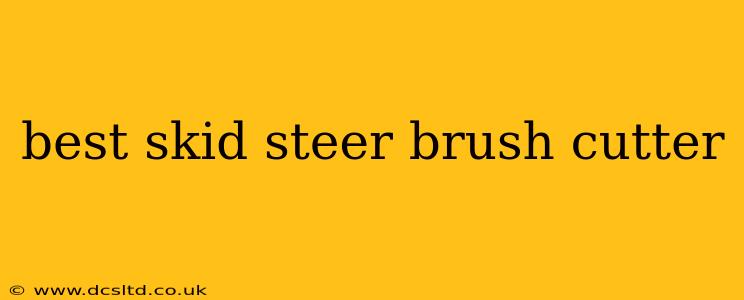Choosing the right skid steer brush cutter can significantly impact your land clearing efficiency and overall project success. This guide delves into the key factors to consider when selecting a brush cutter for your skid steer, ensuring you make an informed decision that aligns with your specific needs and budget.
What to Consider When Choosing a Skid Steer Brush Cutter
Several critical factors influence the selection of the best skid steer brush cutter for your needs. Let's explore them in detail:
1. Cutting Width:
The cutting width directly relates to your project's scale and the speed of your work. Wider cutting widths cover more ground in less time, ideal for large-scale land clearing. However, narrower widths offer better maneuverability in tight spaces and around obstacles. Consider the typical size of the areas you'll be working on to determine the optimal cutting width.
2. Rotor Type and Blade Design:
Brush cutters employ different rotor types and blade designs, each suited for various vegetation types. Hammermill rotors excel at tackling tough brush and saplings, while flail rotors are better for finer material and less dense vegetation. Blade material and design also affect durability and cutting performance. Consider the prevalent vegetation in your area when making this selection.
3. Horsepower Requirements:
The required horsepower depends on the cutter's size and the density of the vegetation. Underpowering your brush cutter leads to inefficient operation and potential damage to the equipment. Always consult the manufacturer's specifications to ensure compatibility with your skid steer's horsepower rating.
4. Skid Steer Compatibility:
Verify the brush cutter's compatibility with your skid steer loader's hydraulic flow and pressure ratings. Incorrect matching can result in suboptimal performance or even damage to your equipment. Check the manufacturer's specifications to ensure a perfect fit.
5. Safety Features:
Safety is paramount. Look for brush cutters with features like a robust protective shield, a readily accessible shut-off switch, and clear operating instructions. These safeguards minimize the risk of accidents during operation.
6. Maintenance Requirements:
Regular maintenance is crucial for prolonging the lifespan of your brush cutter. Choose a model with readily available parts and a straightforward maintenance schedule. Consider the ease of access to components for routine inspections and repairs.
Frequently Asked Questions (FAQs)
What is the difference between a flail mower and a brush cutter?
While often used interchangeably, there are subtle differences. Flail mowers are generally better suited for lighter vegetation, offering a finer cut. Brush cutters, on the other hand, are designed to tackle denser, tougher brush and small trees, resulting in a more coarsely chopped material. The choice depends on the type of vegetation you need to clear.
How much does a skid steer brush cutter cost?
The cost varies significantly based on size, features, and brand. Expect to pay anywhere from a few thousand dollars for smaller, simpler models to tens of thousands for larger, heavy-duty units with advanced features. Research different models and brands to find options within your budget.
What is the best brand of skid steer brush cutter?
Several reputable brands manufacture high-quality skid steer brush cutters. There is no single "best" brand, as the ideal choice depends on your specific requirements and budget. Research brands like Bobcat, Land Pride, Woods Equipment, and others to compare features and prices. Read online reviews and consult with professionals to gather insights on various brands’ reliability and performance.
How do I maintain my skid steer brush cutter?
Regular maintenance is crucial. This includes inspecting blades for wear and tear, lubricating moving parts, checking hydraulic fluid levels, and cleaning debris from the cutter. Refer to your owner's manual for specific maintenance instructions and schedules.
What safety precautions should I take when using a skid steer brush cutter?
Always wear appropriate safety gear, including eye protection, hearing protection, gloves, and sturdy footwear. Clear the area of any obstacles before operating the equipment. Never operate the cutter near bystanders, and always follow the manufacturer's safety guidelines.
Conclusion: Finding the Perfect Match
Selecting the best skid steer brush cutter requires careful consideration of your specific needs, budget, and the type of vegetation you will be clearing. By considering the factors outlined above and researching different models, you can find the perfect brush cutter to efficiently and safely complete your land clearing projects. Remember to always prioritize safety and follow manufacturer recommendations for optimal performance and equipment longevity.
